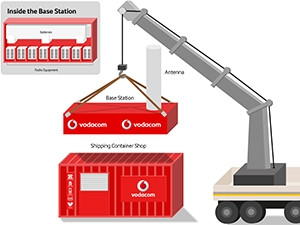
Vodacom will test mobile base stations in shipping container shops, to cope with increasing mobile data use in townships, spurred by the rapid uptake of low-cost smartphones and tablets.
At the end of last year, Vodacom had 16.8 million active data customers, and data traffic countrywide had grown 62% year-on-year. The number of smartphones and tablets active on the network was 9.5 million devices, up 24% on the prior year. The average amount of data used per smartphone was 358MB per month.
Vodacom CTO Andries Delport notes the company is "seeing data volumes in Gauteng's townships almost doubling year-on-year, which is well-ahead of the average growth rate countrywide. Identifying and building new sites to cater for this in densely populated areas has been difficult, and on top of that site security can be an issue."
A standard mobile base station has a site footprint of 30 square metres or more. This includes a mast, which is usually 15 to 25 metres tall and supports the radio antennae that connect to mobile devices. In addition, each site has an equipment storage building to house radio and power equipment. The cost of each installation varies, but can be in the region of R1.5 million.
However, Vodacom's engineers developed a new approach, says Delport. "They repackaged the base station equipment inside a compact steel structure that is then bolted to the roof of existing shipping container shops. This means new sites can be rolled out within weeks as opposed to the typical 12- to 18-month lead time to build new base stations."
The new base stations have a smaller footprint of nine square meters, utilise existing infrastructure, are more energy-efficient, and cost less than half the amount needed to build a traditional site.
These test sites provide mobile coverage over a radius of up to 1.5km and can service 5 000 subscribers at peak times.
Vodacom plans to roll out five sites as an initial test, the first of which to go live is in Alexandra.
Related stories:
Vodacom continues to drive data
Vodacom announces R1bn Gauteng network upgrade
Share